
Orchids are plants that belong to the family Orchidaceae, a diverse and widespread group of flowering plants with blooms that are often colourful and fragrant.

Vanda, abbreviated in the horticultural trade as V., is a genus in the orchid family, Orchidaceae. There are about 87 species, and the genus is commonly cultivated for the marketplace. This genus and its allies are considered to be among the most specifically adapted of all orchids within the Orchidaceae. The genus is highly prized in horticulture for its showy, fragrant, long-lasting, and intensely colorful flowers. Vanda species are widespread across East Asia, Southeast Asia, and New Guinea, with a few species extending into Queensland and some of the islands of the western Pacific.
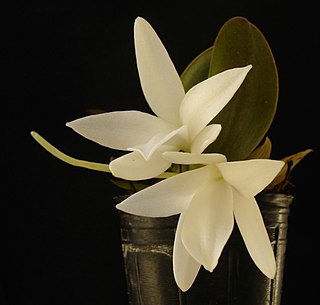
Aerangis, abbreviated as Aergs in horticultural trade, is a genus of the Orchid family (Orchidaceae). The name of this genus has been derived from the Greek words 'aer' (air) and 'angos' (urn), referring to the form of the lip. It is the type genus of the subtribe Aerangidinae, which has recently been subsumed in the subtribe Angraecinae. Approximately 50 species in this genus are known mostly from tropical Africa, but also from the Comoro Islands, Madagascar and Sri Lanka.

Aerides, known commonly as cat's-tail orchids and fox brush orchids, is a genus belonging to the orchid family. It is a group of tropical epiphyte orchids that grow mainly in the warm lowlands of tropical Asia from India to southern China to New Guinea. They are valued in horticulture for their racemes of showy, fragrant, colorful flowers.

× Ascocenda, abbreviated as Ascda in the horticultural trade, was a man-made hybrid orchid genus resulting from a cross between the former genus Ascocentrum and Vanda. It was first described in Orchid Rev. 57: 172 (1949). Ascocentrum is now synonymous with Vanda, so the name is obsolete. Hybrids in the nothogenus × Ascocenda are now properly termed Vanda.

The Armenians in Singapore are a small community who had a significant presence in the early history of Singapore. They were among the earliest merchants to arrive in Singapore were from the British Raj when it was established as a trading port by Sir Stamford Raffles in 1819. They numbered around 100 individuals at their peak in the early 1920s, but most have moved on to other countries or become absorbed into the wider Singapore community. Despite their small number, they had an impact in the commercial life of early Singapore and members of the community co-founded the newspaper The Straits Times and built the Raffles Hotel. The Armenian Apostolic Church of St Gregory the Illuminator on Armenian Street, the second church to be built in Singapore, is today the oldest surviving one.
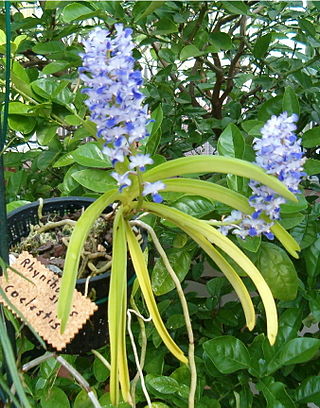
Rhynchostylis is a genus in the orchid family (Orchidaceae), closely allied to the genus Vanda and comprising four currently accepted species native to the Indian Subcontinent, China, Indochina, Malaysia, Indonesia and the Philippines. The name consists of a compound of two Greek elements : rhynchos 'beak' and stylis 'column' – in reference to the very broad, fleshy column of the flower. The flowers are borne in dense racemes and are noted for their intense, spicy fragrance. Although lacking in pseudobulbs, the plants have leathery leaves that are drought-resistant. These orchids grow naturally in warm, moist, shaded tropical areas and will thrive in cultivation if given consistent warmth, uniform moisture and bright, but indirect light. Hobbyists wanting to grow them will need a warm, humid growing environment with gentle air movement. They can be grown in pots, but are better grown in baskets, owing to the extreme fleshiness of their roots. Their unusually fragrant blooms often appear in the slightly cooler winter months.

Amesiella philippinensis is a species of orchid endemic to the Island of Luzon in the Philippines. Like Vanda falcata it was mistaken as an Angraecum species, due to the white, long-spurred flowers. The plant produces rounded leaces up to 5 cm in length. Three or four white, fragrant flowers of 3 cm in width are produced on short inflorescences. The labellum is yellow in the throat. It occurs at lower altitudes than Amesiella monticola and has a shorter spur.

Rhynchostylis gigantea is a species of orchid. This species was first described in 1896 by John Lindley and is native to Borneo, Myanmar, Thailand, Peninsular Malaysia, Laos, Cambodia, Vietnam, China (Hainan) and the Philippines.
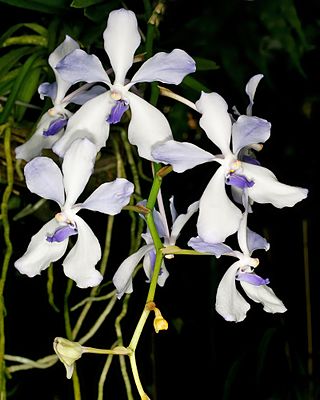
Vanda coerulea, commonly known as blue orchid, blue vanda or autumn lady's tresses, is a species of orchid found in Northeast India with its range extending to China. It is known as kwaklei in Manipuri and vandaar in Sanskrit. It has bluish purple flowers which are very long-lasting compared to other orchids. The plant bears up to 20 to 30 spikes.

Rhynchostylis retusa is an orchid, belonging to the Vanda alliance. The inflorescence is a pendant raceme, consisting of more than 100 pink-spotted white flowers. The plant has a short, stout, creeping stem carrying up to 12, curved, fleshy, deeply channeled, keeled, retuse apically leaves and blooms on an axillary pendant to 60 cm (24 in) long, racemose, densely flowered, cylindrical inflorescence that occurs in the winter and early spring. It is famous for its use as a hair-ornament worn by Assamese women during folk dance Bihu on the onset of spring.

Vanda coerulescens, also known as sky-blue vanda, is a species of monopodial orchid native to Assam and Arunachal Pradesh, India, eastern Himalayas, southern Yunnan province in China, Myanmar and Thailand.

Vanda cristata is a species of orchid found growing in the Himalaya from Bangladesh, India, Nepal, Bhutan to China at elevations of 600 – 2300 meters.

Vanda tessellata is a species of orchid occurring from the Indian subcontinent to Indochina. It is a medicinal plant.
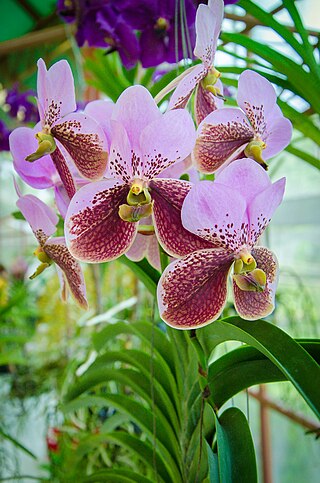
Vanda sanderiana is a species of orchid. It is commonly called Waling-waling in the Philippines and is also called Sander's Vanda, after Henry Frederick Conrad Sander, a noted orchidologist. The orchid is considered to be the "Queen of Philippine flowers" and is worshiped as a diwata by the indigenous Bagobo people.

Papilionanthe Miss Joaquim, also known as the Singapore orchid, the Princess Aloha orchid and formerly as Vanda Miss Joaquim, is a hybrid orchid that is the national flower of Singapore. For its resilience and year-round blooming quality, it was chosen on 15 April 1981 to represent Singapore's uniqueness and hybrid culture.

Vanda falcata, also known as 风兰 in Chinese, 풍란 (pungnan) in Korean, 風蘭 (fūran) in Japanese, or the wind orchid in English, is a species of orchid found in China, Korea, and Japan. It was formerly classified in the genus Neofinetia.
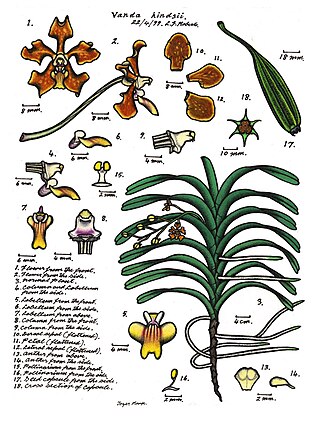
Vanda hindsii, commonly known as the native strap orchid or the Cape York vanda, is a large epiphytic or lithophytic clump-forming orchid. It has thick, white, cord-like roots, branching stems, many thick, leathery, strap-like leaves and between three and seven shiny brown flowers with greenish to yellow markings and a white labellum. This orchid occurs in New Guinea and tropical North Queensland.
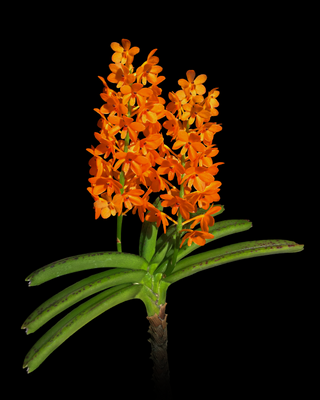
Vanda garayi, or Garay's ascocentrum, is a small monopodial epiphytic orchid native to semi-deciduous and deciduous dry lowland forests of Thailand, Laos, and Sumatra.
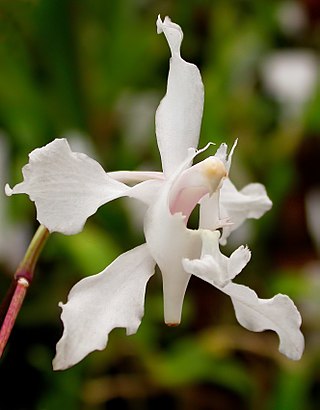
Papilionanthe vandarum is a species of epiphytic orchid native to India, China, Myanmar, and Nepal. Is is closely related to Papilionanthe biswasiana.




















